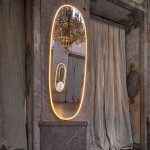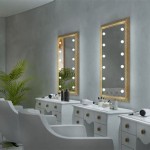The Allure of Vintage Convex Mirrors: History, Design, and Identification
Vintage convex mirrors, often referred to as "witch mirrors," "banker's mirrors," or "bullseye mirrors," hold a unique position in the world of antique décor. Their distinctive shape and historical significance make them highly sought after by collectors and interior design enthusiasts alike. These mirrors, characterized by their outward curve, offer not only a reflection but also a fascinating glimpse into the past.
The defining feature of a convex mirror is its curved surface. This design element results in a wide-angle reflected image, capturing a larger field of view than a flat mirror of the same size. This functionality drove their early adoption in both practical and later, decorative settings. The degree of curvature can vary, with some mirrors exhibiting a gentle bulge and others a more pronounced, almost hemispherical shape. This curvature significantly contributes to the mirror's aesthetic appeal and historical context.
The appeal of vintage convex mirrors lies not only in their functionality but also in their historical context and the craftsmanship involved in their creation. Understanding the history, design variations, and methods for identifying authentic vintage pieces is essential for anyone interested in acquiring or appreciating these captivating objects.
Historical Significance and Evolution
The origins of the convex mirror can be traced back to the 15th century, where they were initially prized for their practical applications. The wide-angle view provided by these mirrors made them invaluable in security contexts. They were strategically placed in shops, banks, and even private homes, enabling individuals to monitor their surroundings without turning their heads. This functionality earned them the moniker "banker's mirrors," particularly in the 18th and 19th centuries.
Beyond security, convex mirrors also served a vital role in navigation. Mariners used them in sextants and other instruments to measure angles and determine their position at sea. The reflective properties and broad field of view offered by the convex shape proved crucial for accurate readings, highlighting the practical utility of these mirrors in various fields.
As manufacturing techniques advanced and glass production became more accessible, convex mirrors transitioned from purely functional objects to decorative items. During the Georgian and Regency periods in England, they became increasingly popular in affluent households. Often adorned with ornate frames made of giltwood, mahogany, or ebonized wood, these mirrors were hung in hallways, drawing rooms, and dining rooms, adding a touch of elegance and sophistication to the interior décor.
The Victorian era witnessed a further evolution in the design of convex mirrors. Manufacturers experimented with different frame materials, including plaster, composition, and even papier-mâché. The frames became more elaborate, incorporating intricate carvings, floral motifs, and other decorative elements. The use of colored glass and mirrored glass accents also became prevalent, reflecting the Victorian penchant for ornate and visually stimulating designs.
By the early 20th century, convex mirrors had become more widely available and affordable, making them accessible to a broader range of households. While the ornate designs of the Victorian era remained popular, simpler and more streamlined styles also emerged, reflecting the changing tastes of the time. Today, vintage convex mirrors continue to be cherished for their historical significance and their ability to add character and visual interest to any space.
Design Variations and Materiality
The design variations found in vintage convex mirrors are extensive and reflect the stylistic trends of different periods. Frame materials, shapes, and decorative motifs all contribute to the unique character of each piece. Understanding these variations is crucial for appreciating the artistry and craftsmanship involved in their creation.
Frames are arguably the most prominent design element and can be crafted from a variety of materials. Giltwood frames, often adorned with intricate carvings and finished with gold leaf, were particularly popular during the Georgian and Regency periods. These frames exude opulence and sophistication, reflecting the wealth and status of their owners. Mahogany frames, known for their rich color and durability, were also favored during this era. Ebonized wood frames, finished with a black lacquer, offered a striking contrast to the reflective surface of the mirror and were often used in more formal settings.
Victorian-era frames often featured more elaborate designs, incorporating plaster, composition, and papier-mâché. These materials allowed for intricate detailing and the creation of complex shapes. Floral motifs, scrolls, and other decorative elements were commonly used to adorn these frames, reflecting the Victorian love of ornamentation. The use of colored glass and mirrored glass accents was also prevalent, adding to the visual richness of the mirrors.
The shape of the frame can also vary considerably. Circular frames are the most common, but oval, rectangular, and even octagonal frames can also be found. The shape of the frame often complements the overall design of the mirror and the style of the room in which it is displayed. The size of the frame can also vary, from small, delicate frames to large, imposing frames that command attention.
The mirror itself is another important design element. The degree of curvature can vary from a gentle bulge to a more pronounced hemispherical shape. The surface of the mirror can be clear or tinted, and some mirrors may feature mercury spotting, which is a common sign of age and can add to the mirror's character. The back of the mirror is typically protected by a wooden or paperboard backing, which may be original to the piece or a later replacement.
The materials used in the construction of vintage convex mirrors are often indicative of their age and origin. Early mirrors were typically made with hand-blown glass, which may exhibit imperfections such as bubbles or striations. The frames were often handcrafted by skilled artisans using traditional woodworking techniques. Later mirrors may have been made with machine-made glass and produced using mass-production methods. Examining the materials and construction techniques can provide valuable clues about the age and authenticity of a vintage convex mirror.
Identifying Authentic Vintage Convex Mirrors
Identifying authentic vintage or antique convex mirrors requires a keen eye and a familiarity with the materials, construction techniques, and stylistic trends of different periods. While reproductions abound, several key indicators can help distinguish genuine vintage pieces from modern imitations.
The condition of the mirror itself is one of the most important factors to consider. Vintage mirrors often exhibit signs of age, such as mercury spotting or cloudiness. Mercury spotting is caused by the oxidation of the mercury backing and appears as small, dark spots on the surface of the mirror. Cloudiness can occur due to the gradual deterioration of the silvering or mercury layer. While these imperfections may detract from the mirror's clarity, they are also evidence of its age and authenticity. It's crucial to differentiate between authentic age-related wear and deliberate distressing, which is often used to mimic the look of vintage mirrors.
The construction of the frame is another important indicator. Handcrafted frames, typically found on older mirrors, will exhibit subtle variations and imperfections that are not present in mass-produced frames. The joints should be tightly fitted, and the finish should show signs of wear and patina. Examine the back of the frame for evidence of old nails or screws, and look for signs of woodworm or other insect damage. The type of wood used to construct the frame can also provide clues about its age and origin.
The style of the frame is also an important consideration. Research the stylistic trends of different periods and compare the frame to known examples of vintage convex mirrors. Pay attention to the shape of the frame, the materials used, and the decorative motifs. Consider the overall design of the mirror and whether it is consistent with the aesthetic of a particular era.
Examine the backing of the mirror. Original backings were often made of wood or paperboard and may be attached with old nails or screws. The backing may also bear markings or labels that can provide information about the manufacturer or retailer. If the backing has been replaced, it may detract from the value of the mirror, but it does not necessarily mean that the mirror is not authentic. A replaced backing might suggest professional restoration, which can be a positive aspect.
Finally, consider the provenance of the mirror. If possible, trace the history of the mirror back to its original owner or to a reputable dealer. Documentation such as receipts, appraisals, or family records can help to establish the authenticity and value of the mirror. However, documentation is not always available, so rely on a combination of factors to make an informed assessment.

Antique Round Convex Mirror Puckhaber Decorative Antiques Specialists In For Over 35 Years London And Rye

Antique Eagle Convex Mirror Round Porthole Wood Painted Gold Federal Style

Vintage Fish Eye Mirror Convex Wall Round Home Decor Gilding

Huge Convex Railway Mirrors Original House Vintage Industrial Furniture And Lighting Decorative Antiques

Convex Mirror Witch Gold Brass Frame Flower Scroll Domed Vintage 60s Wall Hanging Framed Norway

Large Distressed Convex Mirror With Carved Oak Frame For At Pamono

Antique Gilt Convex Mirror Round Regency Wall Pair Of Overmantel And

Antiqued Convex Mirror With Aged Brass Frame Emporium

Eagle Convex Mirror Gold Gilt Vintage Look Hard Plastic Resin Apron 30 X 20

Reion Antique Convex Mirror Courtois Restoration








